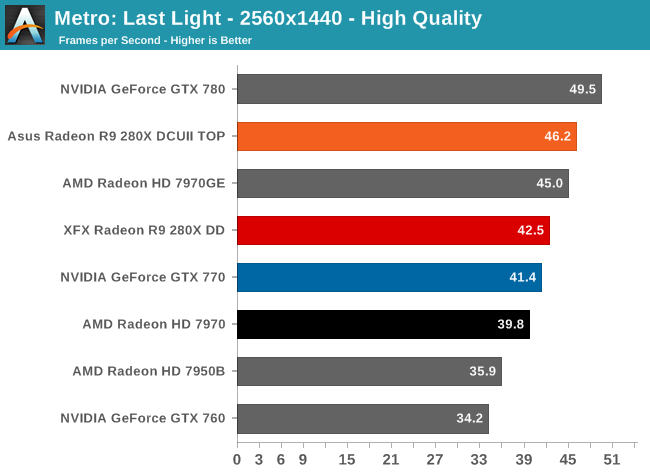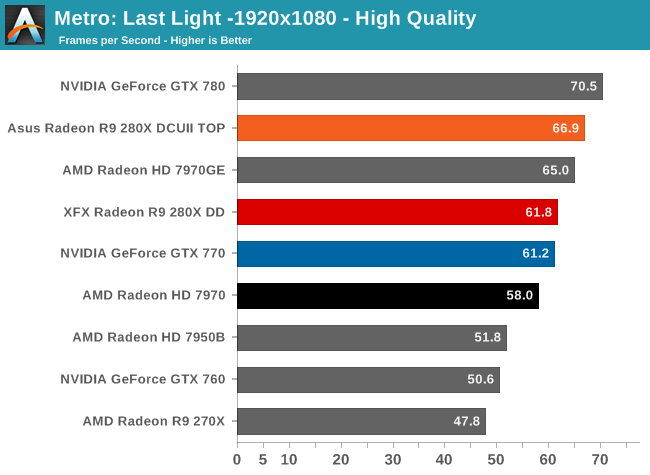The Radeon R9 280X Review: Feat. Asus & XFX - Meet The Radeon 200 Series
by Ryan Smith on October 8, 2013 12:01 AM ESTMetro: Last Light
Kicking off our look at performance is 4A Games’ latest entry in their Metro series of subterranean shooters, Metro: Last Light. The original Metro: 2033 was a graphically punishing game for its time and Metro: Last Light is in its own right too. On the other hand it scales well with resolution and quality settings, so it’s still playable on lower end hardware.



The first benchmark in our revised benchmark suite finds our 280X cards doing well for themselves, and surprisingly not all that far off from the final averages. Setting the baseline here, as we expected the Tahiti based 280X performs in between the original 7970 and 7970 GHz Edition, thanks to the 280X’s use of PowerTune Boost but at lower clockspeeds than the 7970GE. Consequently this isn’t performance we haven’t seen before, but it’s very much worth keeping in mind that the 7970GE was a $400 card while the 280X is a $300 card, so approaching the 7970GE for $100 less is something of a significant price cut for the performance.
As for the immediate competitive comparison, we’ll be paying particular attention to 2560x1440, which should be the sweet spot resolution for this card. At 2560 we can see that the reference clocked 280X doesn’t just hang with the $400 GTX 770 but actually manages to edge it out by just over a frame per second. As a preface we’re going to see these two cards go back and forth throughout our benchmarks, but to be able to directly compete with NVIDIA’s fastest GK104 card for $100 less is a significant accomplishment for AMD.
Finally, let’s quickly talk about the Asus 280X versus the XFX 280X. Asus winning comes as no great shock due to their factory overclock, but now we finally get to see the magnitude of the performance gains from that overclock. At 2560 we’re looking at just shy of a 9% performance gain, which is in excess of both the boost clock overclock and the memory overclock. The specific performance gains will of course depend in the game in question, but this means that the performance gains in at least one instance are being impacted by the base clock overclock, the larger of Asus’s factory overclocks.










151 Comments
View All Comments
Ryan Smith - Tuesday, October 8, 2013 - link
That's the first I've seen of that, so I can't really comment.But when I was discussing Mantle with AMD, they did discount using OpenGL. There was a specific desire to have a pure API that was completely free from legacy cruft (and there's nothing cruftier than OGL) while also being free to quickly evolve the project without having to involve the ARB.
konondrum - Tuesday, October 8, 2013 - link
Well this is one of the most disappointing products launches I've ever seen. At least the nVidia 700 series was more then a sticker change. This isn't even really a price drop as $300 7970s and $200 7870s (with game bundles) have been available for a while. Tell me AMD, why am I supposed to care? If these included TrueAudio at least that would be a differentiating feature, but there is seriously nothing new here at all.The only good thing I can say about this is that it makes me much more comfortable about my current 660ti 3gb. Looks like it will be strong though 2014 at least.
just4U - Tuesday, October 8, 2013 - link
I've yet to see a 7970 GHZ Ed. for under $360.. Hell until a month and a half ago you were lucky to get it under $400 on sale.just4U - Tuesday, October 8, 2013 - link
At any rate this may put some pressure on Nvidia for their 7x series.. I think it's going to be incentive for those still rocking it out on Amd's 6000 series or Nvidia 500 series and earlier to maybe upgrade.Personally I figure if you got a 570/80 or a 6950 (or better) the new stuff by both companies is a bit of a hard sell unless your playing at crazy resolutions... most still sit comfortably in 1080P or 1920/1200 resolution and the old standby 1600/1050.
matagyula - Tuesday, October 8, 2013 - link
I have been looking to replace my now 2 year old HD6870 with something a little beefier, and I was eagerly awaiting AMDs new product launch.But now I am left with even more questions than before - most importantly, should I upgade at all in the upcoming 8-12 months? The card is still putting in solid work, and while I have to settle for mid-high detail settings when it comes to titles like BF3 or Crysis 3, other games perform just fine /DotA 2 and CS:GO @ 1920*1200/.
At the 170-200eur price range I am looking at HD7870, or waiting a couple months for the HD7950 to drop bellow 200eur, while the HD7970 is still at 330eur in Slovakia.
The more I think about it the more I am inclined towards holding off for another year or so :|
ShieTar - Tuesday, October 8, 2013 - link
Stop buying locally. You can order a 7970 for ~240€ from Germany, and delivery to Slovakia should not cost more than ~15€ :http://www.heise.de/preisvergleich/eu/?cat=gra16_5...
Of course an Austrian or Polish shop may be even cheaper for some cards, if the postage is less than for a delivery from Germany. Or depending on where you live, maybe you just go and have a daytrip into either country and bring the card back home ;-)
just4U - Tuesday, October 8, 2013 - link
Well Matt, I sold my 6950 2G and really wanted a 670 or a 7950-70 as I figured that was a decent upgrade. I settled for the 7870 and noticed some ok gains. It's a tough call for you though..The 280X is going to give you 7970GHZ Ed like performance according to reviews.. but basically in the price range of a 7870. Tempting.. but you might get lucky with close out deals on the 7970 or even see price drops on the 770 from Nvidia. that are more attractive. All worthwhile upgrades over the 6870 but not night/day differences.. We really haven't seen a chip come out yet that raises the bar to a whole new level.
piroroadkill - Tuesday, October 8, 2013 - link
Wow. This is a boring card launch.The ASUS card itself is a good SKU, but absolutely nothing that could not have been done branded as 7970.
I understand they have a lot of old GPUs they want to re-use, so they don't want to re-tool them for the TrueAudio DSP, but it is downright stupid that they didn't at least add another small package to the card with the DSP in, so the new range can have feature parity.
AMD, your new card names are terrible, and this launch is pretty bland and watered down.
ninjaquick - Tuesday, October 8, 2013 - link
Well, that is inevitable. AMD's GCN design is not top-down, it is fully modular. IMC / ROP / ShaderClusters are all their own modules, each 'TMU' is attached to 16 'compute cores'. The entire point of the GCN design is that it scales up infinitely. This is why AMD is releasing Mantle. There is no reason to abandon the GCN design in the near future.It is not like AMD is releasing a brand new never seen before design that is the culmination of years of design work. The 290X is literally a 7970 with 12 more ROPs and an extra 128bit memory path which are only needed to accomodate the extra 48 rendering clusters. If you were to take the 7970 and add 48 clusters at the same clock speed you would get *exactly* the same perf as what the 290X delivers. Simple as that.
thylboy - Tuesday, October 8, 2013 - link
I saw on AMD´s homepage that these cards support their "Zero Core" technology. Can anyone confirm whether cards like this actually turn off the fans completely when in the long idle mode or not?